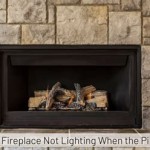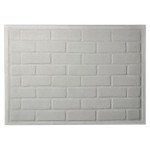Best Color to Paint Stone Fireplace: A Comprehensive Guide
The stone fireplace, often a focal point in a living space, can significantly impact a room's overall aesthetic. While its natural texture and inherent variations are desirable, the existing color of the stone may not always align with evolving design preferences. Painting a stone fireplace presents an opportunity to harmonize it with the room's color palette and create a more cohesive look. However, selecting the appropriate paint color is crucial for achieving the desired outcome and ensuring the fireplace remains visually appealing and functional.
This article explores various factors to consider when choosing the best color to paint a stone fireplace, encompassing architectural style, room design, the qualities of light, and the attributes of different color families.
Understanding the Undertones of Your Existing Stone
Before even considering specific paint colors, a thorough assessment of the stone's existing undertones is paramount. Natural stone, particularly that used in fireplaces, often contains subtle color variations and underlying hues that can significantly influence how a paint color appears. Ignoring these undertones can lead to a clash that makes the painted fireplace look disjointed from the rest of the room.
Examine the stone closely under different lighting conditions. Natural daylight provides the most accurate representation, while artificial light can enhance certain undertones. Note any dominant hues, such as warm browns, cool grays, reddish-browns, or even subtle greens. These undertones should guide the selection of paint colors that either complement or deliberately contrast with the existing stone.
For example, stone with warm, earthy undertones often pairs well with neutral creams, warm grays (greiges), or even muted shades of terracotta or olive green. Conversely, stone with cooler gray or bluish undertones might benefit from being painted a crisp white, a cool gray, or even a very pale blue to enhance its existing character.
Also, consider the type of stone. Limestone tends to have warmer undertones and a more porous surface compared to slate, which is denser and often exhibits cooler, grayer tones. These differences in stone composition will influence how the paint is absorbed and the final color appearance.
Considering Architectural Style and Room Design
The architectural style of the house and the overall design of the room are essential factors in determining the appropriate paint color for the stone fireplace. The fireplace should complement the style and contribute to the overall aesthetic, not detract from it.
In traditional homes, classic colors like off-whites, creams, and soft grays are often ideal choices. These colors offer a timeless appeal and blend seamlessly with traditional furnishings and architectural details. For a more dramatic effect in a traditional setting, consider deeper shades of gray or even muted greens or blues, especially if the room has ample natural light.
Modern or contemporary homes often benefit from a bolder approach. Clean, crisp whites can create a stark contrast and highlight the texture of the stone. Alternatively, shades of charcoal gray, black, or even deep blues can create a striking focal point. The key is to maintain a balance between the boldness of the color and the overall design of the room.
Rustic or farmhouse-style homes often call for warmer, earthier tones. Consider painting the stone fireplace a warm beige, a muted terracotta, or even a soft sage green. These colors evoke a sense of warmth and comfort and complement the natural materials and textures often found in rustic interiors.
Furthermore, carefully assess the existing color scheme of the room. The paint color chosen for the stone fireplace should harmonize with the wall colors, furniture upholstery, and other decorative elements. Ideally, choose a color that either complements the existing colors or provides a subtle contrast that enhances the overall design.
The Impact of Light on Paint Color Selection
Light, both natural and artificial, significantly influences how a paint color appears. The amount and type of light in a room can dramatically alter the perceived color of the stone fireplace after it is painted. It is crucial to carefully consider the lighting conditions before making a final color selection.
Rooms with abundant natural light tend to handle darker and bolder colors more effectively. The natural light will help to soften the impact of the dark color and prevent the room from feeling too closed in. In such cases, consider shades of charcoal gray, deep blue, or even black for a dramatic effect.
Rooms with limited natural light often benefit from lighter and brighter colors. Off-whites, creams, and light grays can help to reflect light and make the room feel more open and airy. Avoid dark colors in poorly lit rooms, as they can make the space feel even smaller and more oppressive.
Consider the direction of the sunlight entering the room. South-facing rooms typically receive warm, yellow-toned light, while north-facing rooms receive cooler, blue-toned light. This can affect how paint colors are perceived. For instance, a warm gray might appear more beige in a south-facing room and more gray in a north-facing room.
Also, consider the type of artificial lighting used in the room. Incandescent lighting tends to cast a warm, yellow glow, while fluorescent lighting tends to cast a cooler, blue glow. Test paint samples under both natural and artificial lighting conditions to ensure that the color appears as desired in different lighting environments.
Using paint samples is invaluable. Paint a sizeable area of the stone (at least a square foot) with different colors and observe how they appear at various times of day and under different lighting conditions. This will provide a much more accurate representation of the final color than simply looking at a paint swatch.
Exploring Color Families and Their Effects
Understanding the characteristics of different color families is crucial for making an informed paint color selection. Each color family evokes a different mood and creates a different ambiance in the room.
Neutrals (Whites, Grays, Beiges):
Neutrals are versatile and adaptable, making them a popular choice for stone fireplaces. White provides a clean, modern look and brightens the space. Gray offers a more sophisticated and subtle alternative, while beige adds warmth and coziness. The undertones of each neutral color, as discussed earlier, must be considered. A warm white might complement stone with yellow undertones, while a cool gray might enhance stone with blue undertones.Warm Colors (Reds, Oranges, Yellows):
Warm colors create a sense of energy, excitement, and warmth. However, they can also be overpowering if used excessively. Consider using warm colors in muted shades, such as terracotta, rust, or ochre, for a more subtle and sophisticated effect. These colors can work well in rooms with cool lighting or in homes with a rustic or Southwestern aesthetic.Cool Colors (Blues, Greens, Purples):
Cool colors evoke a sense of calmness, tranquility, and serenity. Blues and greens are particularly popular choices for creating a relaxing atmosphere. Consider using soft shades of blue or green for a calming effect. Deeper shades of blue or green can create a more dramatic and sophisticated look, particularly in rooms with ample natural light. Purples can be more challenging to work with but can add a touch of luxury and drama when used sparingly.Black:
Black is a bold and dramatic choice that can create a striking focal point. It can be particularly effective in modern or contemporary homes with ample natural light. However, black can also make a room feel smaller and more enclosed if used excessively. Consider using black as an accent color or in a room with high ceilings and plenty of natural light.Ultimately, the best color to paint a stone fireplace depends on a combination of the existing stone's undertones, the architectural style of the home, the overall design of the room, and the impact of light. By carefully considering these factors, a homeowner can make an informed decision that will enhance the beauty and functionality of the fireplace and create a more cohesive and aesthetically pleasing living space.

Best Stone Fireplace Paint Colors You Should Consider Painting

See How I Made Over An Ugly Clunky Stone Veneer Fireplace With Paint

Creative 25 Best Ideas About Painted Stone Fireplace On Brick Fireplaces Makeover

How To Paint A Stone Fireplace True Value

How To Paint A Stone Fireplace

How To Painting The Stone Fireplace White Greige Design

Painted Stone Fireplace Makeover The Little By Home

Living Room Paint Colors With Wood Trim And Stone Fireplace Google Search For Remodel Grey

Painted Stone Fireplace Makeover The Little By Home

Best Stone Fireplace Paint Colors You Should Consider Painting
Related Posts








